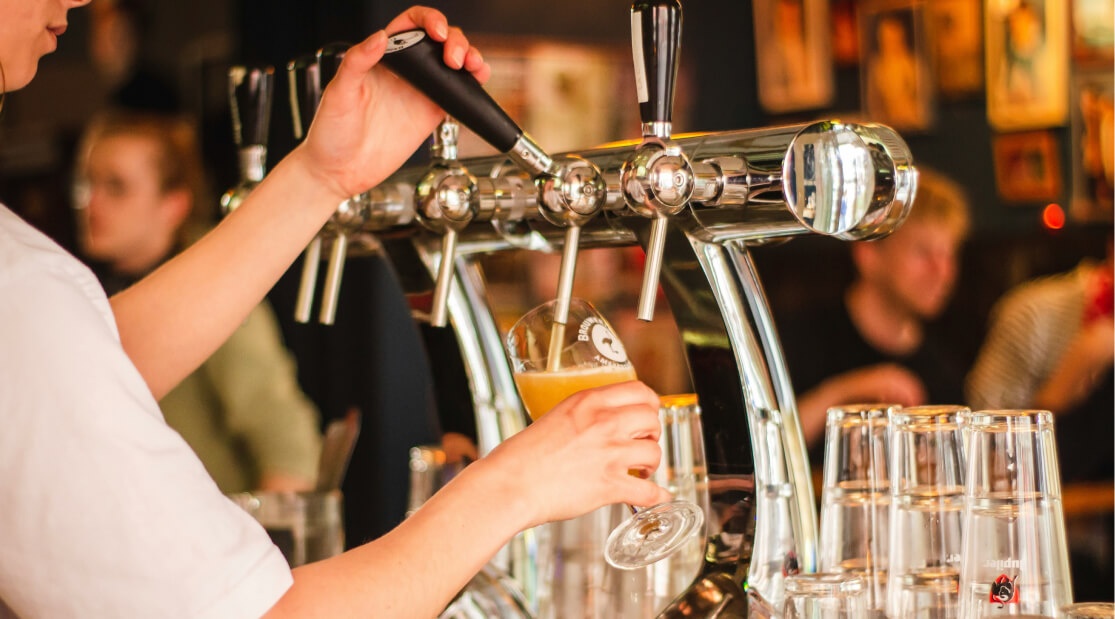
The craft beer industry has experienced remarkable growth in recent years, with many entrepreneurs wondering how much breweries make and if opening a brewery is a viable business venture. This comprehensive guide explores the financial aspects of owning and operating a brewery, from startup costs to profit margins. We’re going to dive into the factors that influence brewery profitability, discuss strategies to boost sales, and examine the importance of a strong online presence in today’s competitive market. Whether you’re considering opening a brewery or looking to improve your existing business, this article will provide valuable insights into the economics of brewing. So, let’s dive into the world of hops, malt, and profits!
On average, small to medium-sized craft breweries can have annual salary ranging from $100,000 to several million dollars. However, it’s important to note that revenue doesn’t equate to profit. The brewing industry is known for its high operating costs, which can significantly impact a brewery’s bottom line.
Brewery owners may see their total brewery sales increase over time as they build brand awareness and expand distribution. Some successful craft breweries have reported annual sales in the millions, while others may struggle to break even in their first few years of operation. The key to understanding how much breweries make lies in analyzing their profit margins and operational efficiency.
The profitability of breweries can vary significantly, but with proper planning and management, they can indeed be profitable ventures. Many factors influence a brewery’s profitability, including production costs, distribution strategies, and market demand. While some breweries may become profitable within a few years of opening, others may take longer to see a return on their investment.
One of the challenges facing brewery owners is the need to reinvest profits back into the business, especially during the early stages of growth. This can impact short-term profitability but is often necessary for long-term success. Additionally, the craft beer market has become increasingly competitive, making it essential for breweries to differentiate themselves and create a strong brand identity to remain profitable.
When it comes to brewery owner’s salary, it’s important to understand that income can vary significantly based on the brewery’s size, profitability, and stage of growth. In the early years, owners may need to reinvest profits back into the business, resulting in modest personal earnings. As the brewery becomes established, owners might draw salaries ranging from $20,000 to $100,000 or more annually. However, many choose to keep their salaries low, focusing on reinvestment and growth. The potential for long-term financial success often outweighs the desire for immediate high salaries in this industry.
With Menubly, you can create a free website with built-in online menu, and a hub for all your essential links like table reservations, social profiles, location, promotions, etc.

The average brewery profit margin typically falls within the 10-20 % range, though it’s significantly higher for well-established breweries with efficient operations and strong brand recognition. Profit margins in the brewing industry can be compared to profit margins for restaurants and bars, which often face similar challenges.
Factors influencing profit margins include production costs, distribution strategies, pricing, market competition, and operating expenses. Microbreweries and taprooms often make higher margins compared to large-scale production breweries, as selling beers retail directly to consumers allows for better markups.
It’s crucial to regularly analyze and forecast your brewery’s sales and expenses to maintain a healthy profit margin. Tools like a beer profit margin calculator can help you determine optimal pricing strategies and identify areas for improvement. With the right strategies and careful financial planning, you can boost brewery profitability and ensure long-term success in this competitive industry.
Starting a brewery requires a significant upfront investment and proper financial plans. The total start up costs for brewery can range from $250,000 to $2 million or more, depending on factors like location, size, and equipment quality.
Here’s a breakdown of major expenses:
| Expense Category | Cost Range |
|---|---|
| Brewery Equipment | $100,000 – $1,000,000+ |
| Space (Lease/Purchase) | $50,000 – $250,000+ |
| Licenses and Permits | $5,000 – $20,000 |
| Initial Inventory | $20,000 – $50,000 |
| Utilities and Insurance | $10,000 – $25,000 annually |
| Marketing and Branding | $10,000 – $50,000 |
| Working Capital | $50,000 – $250,000+ |
These costs include top-of-the-line equipment necessary for brewing operations, such as fermentation tanks, kettles, and bottling lines. The space to brew is another significant expense, whether leasing or purchasing a suitable location.
Licenses and permits are crucial and can vary by location. Initial inventory covers ingredients like hops and malt, as well as packaging materials. Monthly expenses like utilities and insurance should also be factored into your startup budget.
Marketing and branding are essential for establishing your presence in a competitive market. Lastly, setting aside working capital to cover 3-6 months of operating expenses is crucial for weathering initial challenges.
Remember, these are estimates, and actual costs may vary. It’s important to create a detailed business plan and consult with financial advisors experienced in the brewing industry to get a more accurate forecast for your specific situation.
Calculating profit margin is crucial for understanding your brewery’s financial health and profitability. Here’s a step-by-step guide to calculating both gross profit margin and net profit margin:
1. Calculate Total Revenue:
Total Revenue = Number of Units Sold × Average Price per Unit
For example, if you sold 10,000 pints at an average price of $6:
Total Revenue = 10,000 × $6 = $60,000
2. Calculate Cost of Goods Sold (COGS):
COGS includes direct costs like ingredients, packaging, and production labor. Let’s say your COGS is $30,000 for the 10,000 pints produced.
3. Calculate Gross Profit:
Gross Profit = Total Revenue – COGS
In our example: Gross Profit = $60,000 – $30,000 = $30,000
4. Calculate Gross Profit Margin:
Gross Profit Margin = (Gross Profit ÷ Total Revenue) × 100
In our example: Gross Profit Margin = ($30,000 ÷ $60,000) × 100 = 50%
5. Calculate Operating Expenses:
Include costs like rent, utilities, marketing, and administrative salaries. Let’s say operating expenses are $20,000.
6. Calculate Net Profit:
Net Profit = Gross Profit – Operating Expenses
In our example: Net Profit = $30,000 – $20,000 = $10,000
7. Calculate Net Profit Margin:
Net Profit Margin = (Net Profit ÷ Total Revenue) × 100
In our example: Net Profit Margin = ($10,000 ÷ $60,000) × 100 = 16.67%
To boost your brewery’s profit margin, consider the following strategies:
The pandemic has shown the importance of adaptability in the brewing industry. By implementing these strategies and continuously monitoring your financial performance, you can work towards increasing your brewery’s profit margins and ensuring long-term success in the competitive craft beer market.
The break-even point is where total revenue equals total costs, resulting in zero profit or loss. To calculate it, you’ll need to consider both fixed costs and variable costs.
Fixed costs remain constant regardless of production volume, such as rent, insurance, and equipment leases. Variable costs change with production volume, including ingredients and packaging materials. Use the following formula to calculate your break-even point:
Break-even Point (in units) = Fixed Costs ÷ (Price per Unit – Variable Cost per Unit)
For example, if your brewery has annual fixed costs of $200,000, sells beer at $7 per pint, and has variable costs of $2 per pint:
Break-even Point = $200,000 ÷ ($7 – $2) = 40,000 pints
This means you need to sell 40,000 pints annually to break even. Any sales beyond this point contribute to profit. Keep in mind that the break-even point can vary greatly depending on the brewery’s size, location, and business model.
It’s important to regularly review and update your break-even analysis, especially as your brewery grows and costs change.
Boosting your brewery’s profit margin is essential for long-term success and growth. Here are strategies to help increase your profitability:
Increasing profit margins is an ongoing process. Regularly review your strategies and be prepared to adapt to changing market conditions, including factors like inflation and shifts in consumer behavior.
If you found this guide on sandwich shop profitability helpful, you might also be interested in exploring the financial aspects of other food service businesses:
These articles provide valuable insights into various food service business models and can help you make informed decisions about your entrepreneurial journey in the food industry.
Owning a brewery can be a rewarding venture, but it requires careful financial management and strategic planning. From understanding startup costs and break-even points to maximizing profit margins, success in the brewing industry depends on a combination of passion for craft beer and sound business acumen. While challenges exist, including the need for a lot of cash up front and potential fluctuations in monthly sales, the craft beer market continues to show promising growth and demand.
As you navigate your brewery’s financial landscape, remember to regularly estimate your brewery’s performance, maintain contingency funds, and stay adaptable to market changes. With proper planning and execution, your brewery can thrive in this dynamic industry. For more insights on running a successful beverage business, explore our related articles on various restaurant and bar concepts.
Turn your paper menu into an interactive online menu that your customers can browse and order from anywhere.